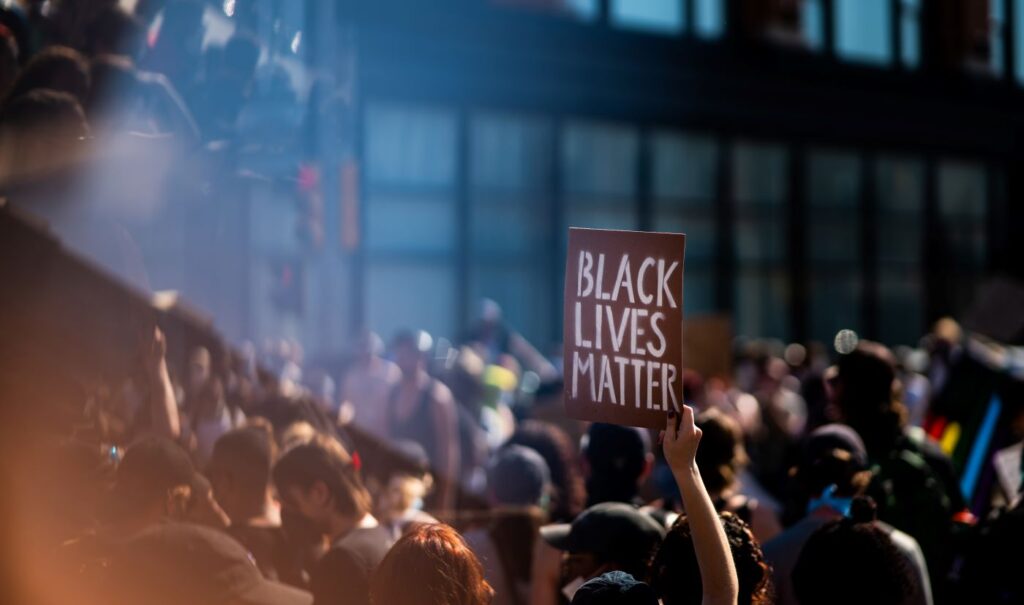What is Critical Race Theory?
A movement that was virtually unknown for decades is now, thanks to prominent national activism, a household name. The United States continues to grapple with the legacy of slavery and the persistence of racism. For many, Critical Race Theory (CRT) seems to be the most plausible and coherent framework through which to view the history of racism and its lasting impact on modern life. But as Edward Feser argues in All One in Christ: A Catholic Critique of Racism and Critical Race Theory, CRT does more harm than good for racial harmony, an ideal that is better served by such Christian principles as those embodied in the Catholic Church’s social teaching. In Feser’s book, Catholics, other Christians, and even non-Christians will find much to help them confront CRT and the perennial challenges of living in a racially diverse society.
The Christian Response to Racism
The Compendium of the Social Doctrine of the Church states:
Start your day with Public Discourse
Sign up and get our daily essays sent straight to your inbox.The Incarnation of the Son of God [Jesus Christ] shows the equality of all people with regard to dignity: “There is neither Jew nor Greek, there is neither slave nor free, there is neither male nor female; for you are all one in Christ Jesus” (Gal. 3:28).
Since something of the glory of God shines on the face of every person, the dignity of every person before God is the basis of the dignity of man before other men. Moreover, this is the ultimate foundation of the radical equality and brotherhood among all people, regardless of their race, nation, sex, origin, culture, or class.
Only on such a principled basis, Feser says, could one overcome racism. Biology can refute many racist claims, but hardened racists can always find genetic differences between races to rationalize their prejudice. Defenders of universal human dignity, like the Church, therefore ultimately appeal to the transcendent human nature that we all share in our spiritual soul—which cannot be reduced to genetics.
From each man’s soul—“by which he is most especially in God’s image”—spring his distinctly human capacities to know and love God and other people. It creates a “bond between the human person and the Creator,” the Church says, that grounds his “fundamental inalienable rights, of which God is the guarantor.” God alone, and not one’s parents, creates the soul. It is immortal, and after separating from the body in death it will reunite with the body “at the final Resurrection.” And if he develops his spiritual capacity to love, even the humblest, least educated person—like St. André Bessette—will, after this life, surpass in eternal glory kings and popes who were reckoned among the mighty on earth.
Given the Church’s beliefs, it is not surprising that, when race-based slavery first appeared in the early modern era, Feser notes, “[t]he Church immediately condemned [it] in the harshest terms possible.” In 1537, Pope Paul III bluntly called the opinion that the native peoples of the New World were mere animals the invention of
[t]he enemy of the human race, who . . . in order that he might hinder the preaching of God’s Word of salvation to the people, . . . inspired his satellites . . . to publish abroad that the Indians of the West and the South, and other people of whom We have recent knowledge, should be treated as dumb brutes created for our service, pretending that they are incapable of receiving the catholic faith.
In other words, Feser says, “in this document from five centuries ago, the pope characterizes as nothing less than satanic” the racism that underlay slavery. The same natives, the pope said, “and all other people who may later be discovered by Christians, are by no means to be deprived of their liberty or the possession of their property, even though they be outside the faith of Jesus Christ.”
Although many Catholics ignored the pope, the Church’s teaching was clear and emphatic. Over centuries, the teaching was repeated and extended to condemn the enslavement of Filipinos and black Africans. Leo XIII applauded slavery’s abolition in Brazil in 1888. And when Nazism emerged, Pius XI condemned its racist nationalism. Throughout the twentieth and twenty-first centuries, popes have continued to speak out against the mistreatment of minorities.
Defenders of universal human dignity, like the Church, appeal to the transcendent human nature that we all share in our spiritual soul—which cannot be reduced to genetics.
CRT 101
It is hard to overstate how different Catholic teaching about human dignity is from Critical Race Theory. As exemplified in Ibram X. Kendi’s How to Be an Antiracist and Robin DiAngelo’s White Fragility, CRT, rather than rejecting racism, fights one form of it with another.
“The fundamental assertion of CRT,” Feser writes, “is that racism absolutely permeates . . . every social institution and the psyches of every individual.” It allegedly infects not just white people but even nonwhite people, insofar as they participate in those social institutions. “[E]ven societies free of . . . overt expressions of bigotry, and even whites who explicitly reject racism, are in fact racist, usually without realizing it.” In such populations, racism takes the form of “micro-aggressions”—small acts, like failing to smile at someone, that can be conscious or not—and “implicit bias”—the “unconscious association” of certain ideas with certain races, that might lead a white person, say, to discriminate against a black person during a hiring process. That social institutions are racist is proven by the existence of “any ‘inequity’ or ‘disparity’ . . . between whites and members of other racial groups.” Unless each race is represented in each profession, class, or other segment of a society in perfect proportion to its share of the total population, that society must be racist.
While most Christians might associate racism with deliberately abusive actions or attitudes—that is, sins—or with careless offensive remarks, CRT views racism as a structural problem, as Kendi says, “of power, not . . . of immorality or ignorance.” Therefore CRT eschews persuading others through the language of natural rights and is willing to use violent, “cataclysmic and convulsive” methods if necessary.
CRT is faithful to the Marxist ideology from which it sprang: it holds that society determines the individual and that a root-and-branch social revolution is the only solution to evil. This social determinism leads CRT openly to embrace moral relativism, as DiAngelo admits in her book: “[W]e don’t see through clear or objective eyes—we see through racial lenses.” CRT theorist Kimberlé Williams Crenshaw even says “it is politically inexpedient for black people to think of themselves primarily as persons (as opposed to primarily as black persons, specifically).” A “race-neutral” society would, in Kendi’s words, be “the most threatening racist movement.”
According to critical race theorists, the source of today’s structural racism is “whiteness.” White people who “deny harboring racism . . . confirm that they are racists precisely by denying it,” a behavior CRT calls “white fragility.” DiAngelo, herself of European descent, says “anti-blackness is foundational to our very identities as white people,” hence whites must struggle their whole lives to overcome their racism, although they have no hope of succeeding.
At the social level, overcoming racism against nonwhites requires “racial discrimination in [nonwhites’] favor and against whites.” Affirmative action in college admissions, for example, is sometimes justified on this basis. According to Kendi, CRT’s advocacy of anti-white discrimination is not self-contradicting: “if discrimination is creating equity, then it is antiracist.” Nothing short of tireless thought-policing may be necessary, he suggests: “[L]ike fighting an addiction, being an antiracist requires persistent self-awareness, constant self-criticism, and regular self-examination, . . . a radical reorientation of our consciousness.”
“The implications [of CRT] couldn’t be more radical,” Feser concludes. CRT does not seek Dr. Martin Luther King’s dream of a future where “the sons of former slaves and the sons of former slave owners will be able to sit down together at the table of brotherhood,” and where “my four little children will . . . live in a nation where they will not be judged by the color of their skin but by the content of their character.” CRT rather seeks a totalitarian “anti-racist” regime that only further alienates people from each other.
CRT is faithful to the Marxist ideology from which it sprang: it holds that society determines the individual and that a root-and-branch social revolution is the only solution to evil.
Bad Arguments
Though many people are averse to CRT’s harsh tone, they may also find it hard to refute. This difficulty is no surprise: critical race theorists routinely use confusing, tough-to-pin-down logical fallacies. Feser does us the service of laying these fallacies out methodically and succinctly.
CRT theorists employ ad hominem fallacies when they dismiss contrary arguments as merely the fruit of “white advantage” or “white fragility.” Rather than considering objections to CRT on their merits, Feser argues, critical race theorists deflect, introducing irrelevant questions about “the character or interests of the person making [such counterarguments].” They ignore the fact that the truth of a claim is independent of the virtue of the person making it. Ad hominem thinking would condemn the Declaration of Independence’s defense of the universal rights to “life, liberty, and the pursuit of happiness,” because many of its signers owned slaves. But even the former slave Frederick Douglass said of the Founding Fathers that, although “[t]he point from which I am compelled to view them is not, certainly, the most favorable, . . . I cannot contemplate their great deeds with less than admiration,” because they “seized upon eternal principles.”
Critical race theorists also frequently commit “fallacies of presumption” by presupposing the truth of their conclusions, instead of marshaling external evidence for them. DiAngelo seems to admit this when she says, “Whiteness Studies begin with the premise that racism and white privilege exist, . . . and rather than work to prove [their] existence, work to reveal it.” CRT also claims that no one can be objective about racism, but CRT is not willing to say “that CRT itself does not reflect objective reality, but merely the perspective and interests of CRT writers and those they claim to speak for.”
Critical race theorists also appeal less to reason through argument than to emotions through narrative, encouraging people to think less and feel more. Worst of all, CRT leads people to violate the all-important “principle of charity:” that one ought to analyze one’s opponent’s argument in its strongest form, and entertain from the outset the possibility that it might be true.
Bad Science
Much of CRT appeals to social science, but there, too, it rests on shaky ground. As Feser explains, Thomas Sowell (an African-American) has demonstrated in Intellectuals and Race and Discrimination and Disparities how the facts do not support CRT’s allegation that contemporary America is systemically racist.
For instance, although whites today on average do better than blacks in numerous economic indicators, Asians outperform both, suggesting that the “system” is not rigged in whites’ favor. Moreover, “black-owned banks turn down black mortgage applicants at a higher rate than white-owned banks do,” a fact that seems hard to attribute to anti-black racism. CRT might allege that black bank owners “have picked up a self-defeating antiblack animus from the surrounding white supremacist culture, . . . [b]ut the problem is that there is no evidence for this claim.” Furthermore, if perfectly proportionate ethnic distribution in all economic sectors were the mark of a non-racist society, then one would have to call racist those many societies in which minorities have played a disproportionately large role in the economy, as the Chinese have done in Malaysia, the Greeks in the Ottoman Empire, and Jews in pre–World War II Poland.
Why some groups succeed economically and others do not has less to do with discrimination than with chance and, more importantly, what Feser and others call “culture—the values, beliefs, customs, habits, and the like shared by people and passed on from generation to generation.” Feser does not mean to suggest that economically successful cultures are absolutely superior to others. “The point,” he writes, “is simply that cultural differences clearly play a major role in explaining economic disparities between some groups. There is plainly no basis for insisting that discrimination or ‘systemic racism’ must be the explanation.”
The most important cultural cause of positive outcomes, Feser says, is “the relative stability of the family.” And the fact is, as David Popenoe and others have shown, that there is more family instability—especially fatherlessness—among black Americans than whites, and more among whites than among Asians. Nor, Sowell says, can one attribute instability in the black family to racism as “a lingering effect of slavery,” since it arose well after slavery ended. “As recently as 1960, two-thirds of black children were still living in two-parent families,” and “[a] century ago, a slightly higher percentage of blacks were married than whites.” Sowell speculates that family breakdown correlates better to the growth of the welfare state—and of ideologies that downplayed personal responsibility—which encouraged people to delegate their duties as parents to the government. Others, like Janet Yellen, have tied it to the promotion of contraceptives, which foster the sexual promiscuity that inevitably results in out-of-wedlock childbirths.
Regarding CRT’s claim that contemporary society is infected with “implicit bias,” Feser argues that no psychological test has been able to detect it consistently, and those who test positive for it are often those who seem most respectful of minorities. As for micro-aggressions, studies that claim to demonstrate their existence usually use unreliably small sample sizes. In any case, the definition of these phenomena is so subjective that it is hard to test for them.
One Cannot Fight Racism with More Racism
Feser’s book is quite brief; the reader who wants to understand CRT in greater depth, beyond the writings of DiAngelo and Kendi, will have to look elsewhere. Nevertheless, for anyone who knows nothing about CRT, All One in Christ is an excellent place to start. It has a decidedly negative perspective on the movement, but Feser takes pains to be fair to his opponents. His overall approach is positive: to present the authentic Christian view of the dignity of every human being.
Reading the book brings to mind Yuval Levin’s comments about a contemporary college seminar he attended on civil disagreement:
One after another students reported great difficulty in navigating a terrain [in college] of intercutting cleavages of race, gender, ethnicity, and sexuality without giving offense or unknowingly stepping on landmines. . . . They seemed to exist in unending terror of saying the wrong thing to the wrong person—and not because they might be punished somehow but out of a genuine concern about giving offense or seeming insufficiently respectful of someone else’s experience.
Whatever its proponents’ intentions may be, Critical Race Theory can only deepen racial divisions and social anxiety. Rather than bring peace, it trains us to live in constant fear of our own thoughts and distrust of our own judgment.
As Feser shows, one cannot fight one kind of racism with another. We must do what we can to repair the damage of past sins. But the ultimate solution to racism is to raise our sights above mere earthly considerations of power and success, and consider the higher calling God makes to us all—black or white, slave or free, woman or man: to love, forgive, and ask forgiveness from one another as God’s children.
Image by AlexanderIO and licensed via Adobe Stock. Image resized.














